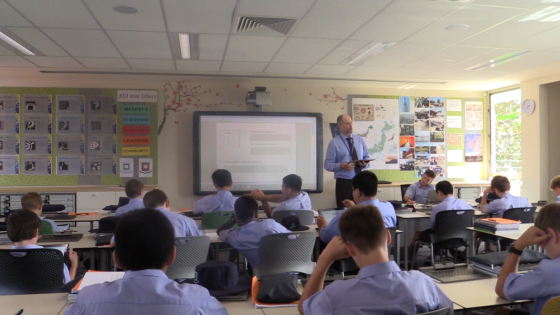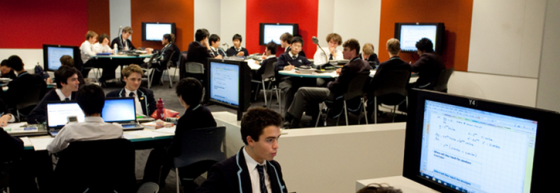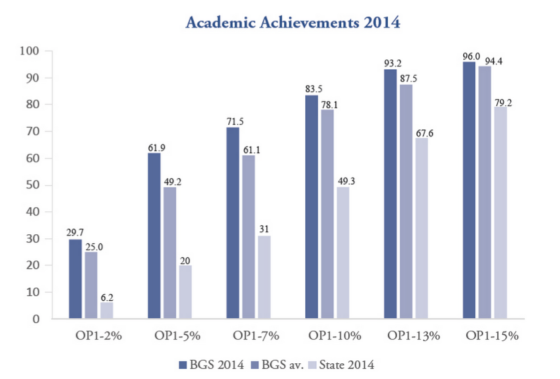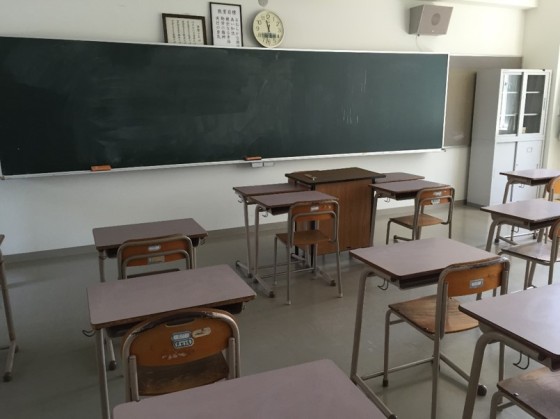By Stephen Howes
The education landscape has always seen change. It is a constantly evolving profession that has an enormous number of influences, whether they are societal or individual, pedagogical or policy-driven. Perhaps there has not been as great an influence to change as the technological advances of the past ten years though. As Gonzales and Vodicka (2012) state, the disruptive innovation that has been thrust upon us now aims to cause non-traditional changes to improve the education system. This paper aims to contrast technological change and its effects within one school in Australia and the limited use of technology in another school in Japan. It will describe, as experienced by the author, the education technology that exists in each school and the implications of each environment on student potential.
Brisbane Grammar School is a private non-denominational school with approximately 1700 boys ranging from Years 5-12 in Brisbane, Queensland, Australia. It has prided itself on its outstanding academic outcomes, the extracurricular opportunities it provides for students and the student welfare program embedded in the curriculum. According to their website (Brisbane Grammar School, 2015), the academic vision of the school is to achieve “national leadership in innovative, research-driven teaching and learning practice”. A strong emphasis is placed on providing the students and teachers with the most up-to-date resources available and on an education that reflects the traditional 148-year history of the school, but which nevertheless prepares the students for 21st century thinking. The facilities reflect this vision. The historic Great Hall, built around 1880 and adorned with elaborate stained-glass windows sits next to The Lilley Centre, built in 2010, with its modern glass and steel-framed architecture. More examples of this coexistence are seen throughout the school, including inside the classrooms.

Brisbane Grammar School’s Great Hall reflected on The Lilley Centre
In the period between 2008 and 2015, the time period the author was teaching at the school, the classrooms transformed from whiteboards and projector screens fixed to the ceilings to almost every classroom containing interactive whiteboards, and in some cases wirelessly connected. The Lilley Centre contains larger learning spaces that were designed specifically for collaboration, with tables seating six and an LCD screen at the end of each table for a student to display work. Furthermore, these screens could be controlled by the teacher of that class to display work from specific tables on the main screen. This style clearly supports Hattie’s (2009) notion that the teaching should be visible to the student, just as the learning should be visible to the teacher. The entire campus is fitted with Wi-Fi connectivity and is managed by approximately 10 non-teaching staff in the Information Technology (I.T.) department.

Author teaching using tablet computers
In the first term of their school experience in Grade 7, the school provides each student with a tablet PC pre-installed with up-to-date software, security and insurance. The cost of the device is factored into each student’s school fees. The tablet PC, with a detachable screen and keyboard, was specifically chosen for its ability to maintain the traditional skills of writing (on a touch screen) and flexibility of switching to keyboard input. In addition, the stylus pen was specifically chosen to mimic a non-digital pen. All departments of the school were consulted on their desires, whether they be structural or digital, before the mass purchase and rollout of machines. The students were given a detailed orientation session when given their machines, as well as numerous follow up induction lessons in the subsequent weeks on the use of specific software and general maintenance. In addition to this, explicit lessons on digital citizenship were given during their student wellbeing class.
The rapid introduction of technology greatly influenced the pedagogical approach of teachers. Nevertheless, technology was not always used simply because it was available. The direction given by the leadership team was to use technology in an innovative way that benefits the learner, or do not feel compelled to use it at all. As per Senge (1999), learning to change is not the objective; changing to learn is the key mindset necessary. In most cases, teachers chose to adopt an innovative approach because of the unforeseen levels of motivation, creativity and enthusiasm from the learners.
On top of the existing framework for teaching that had existed pre-tablet introduction, the teachers developed new approaches to their teaching and learning, such as flipped and blended learning and design thinking. The software installed in the machines as well as beneficial sites discovered by the teachers (and students) enabled students to learn synchronously, at the same time as the teacher using the software, or asynchronously (e.g. at home). The result was an increase in connectedness within the class and with the global community at large, and an increase in personalised and self-directed learning. However, the depth to which the students understood and wanted to extend themselves further was the most encouraging outcome for teachers. With the ease of access to overwhelming sources of information, the path of their learning was seeing a greater emphasis in critical thinking and other complex reasoning processes such as justification, inductive and deductive reasoning, and analysing perspectives. Likewise, the formative and summative assessment instruments created by teachers were evolving creatively within the new landscape, such as book trailers instead of book reports, and video presentations via green screens instead of oral presentations.

BGS students using the collaborative spaces
Currently, the flow of technological integration has yielded the senior year students with an unexpected surprise. School policy dictated that students were to refrain from using their mobile phones at school. However to improve the Wi-Fi compatibility and robustness, it was decided that senior students would be permitted to use them on campus as a “Bring Your Own Other Device” (B.Y.O.O.D.). This has once again expanded the pedagogical implications of having another tool to utilize.
With the introduction of anything new, in particular technology-related, there is scepticism. Changing what has been deemed successful practise for an extended period of time can produce feelings of disillusionment with many parents, teachers and in some cases students, as they struggle to maintain normality (Senge, 1999). However, the exit results of the 2014 cohort defied the sceptics and provided evidence in support of a learning environment that has successfully integrated technology. The 2014 cohort of students were the first group to experience their entire high school curriculum using tablet PCs. As seen in Figure 1, the “Overall Position” (OP) scores for the cohort were the highest achieved by the school in its 147-year history (until 2014). The OP is the rank given to the students based on their individual subject results relative to state benchmarks combined with their score in the mandatory Queensland Core Skills Test (QCST). A ranking score of 1 is the highest and 24 is the lowest, and these scores are used to gain entry into specific courses at Queensland universities. Of the 250 students in the cohort, 29.7% achieved a score of 1 or 2. Furthermore, 57.4% of the students achieved a score of “A” in the QCST (Figure 2). Both of these scores were well above the state average and BGS average.

Figure 1: Brisbane Grammar School “Overall Position” (OP) scores in 2014 (source)

Figure 2: Brisbane Grammar School’s Queensland Core Skills Test (QCST) results in 2014 (source)
A common misconception amongst Australian students is that anything and everything in Japan uses the latest technology. However, the situation of technology-integration in most schools in Japan has not kept up with the image perceived overseas. This common misconception is perhaps fuelled by their exposure to Japanese exports such as the brand of their electronics, the maker of their automobiles, or the adolescent hobbies of anime or video games. As Anthony Salcito, Vice President of Education for Microsoft Corporation’s Worldwide Public Sector organization states, “What intrigues me about Japan is that the country has a very technology rich society, but the school systems are technology resistant” (2010).
Tokyo Seitoku University Fukaya High School and Junior High School are private co-educational schools with roughly 800 students in total, on the same campus in Saitama Prefecture. There is limited use of modern technology within the school, with the school maintaining the traditional blackboard and chalk classrooms. There are two computer rooms with desktop machines running on outdated operating systems, and a couple of other larger rooms capable of using DVDs on larger screens. However, as of August 2015, there seems to be little discussion about whether to implement any 21st century educational tools in the classrooms and little to no consultation with the educational trends outside the walls of the campus. Furthermore, as a symptom of this environment, teachers are not encouraged to investigate or seek professional development in the area of education technology.

A familiar sight to most Japanese secondary school teachers
This school’s situation may not be considered an anomaly though. At a recent conference for the International Symposium on Learning Sciences, Professor Yuichiro Anzai (2015) honestly portrayed the current situation and issued a dire warning that the education system needs to change. Anzai (2015) was critical of the over-emphasis on rote learning, both in instruction and its effect on the validity and reliability of assessment. In general, it is feared that students are not being prepared for 21st century learning, and interaction in the future global and local society (Anzai, 2015). Encouragingly, there are reforms being put in place to change the assessment instruments, which will hopefully inspire a pedagogical shift.
The difference between the Australian school and Japanese school’s learning environments are quite noticeable. The Australian school is at the forefront of integrating technology in education and preparing their students for a 21st century society. The Japanese school has not reached that stage yet and moreover, will not change suddenly. The Australian school made incremental changes that integrated with the ordinary school experience. These incremental changes were made by a team that was willing to experiment and report its failures and successes honestly. The educators have to be learners along with the students. This situation offers the perfect opportunity to model the process of learning itself. However, above all, the leadership team of the school has to have a clear purpose for changing, and that purpose is to improve the education for students in order to prepare them for the future.
References
Anzai, Y. (2015). Education at the turning point: Opportunities for cognitive and learning sciences. Paper presented at International Symposium on Learning Sciences: What matters most, University of Tokyo, Japan, 26 July, 2015.
Brisbane Grammar School (2015). Academic results. Retrieved August 7, 2015 from https://www.brisbanegrammar.com/About/AcademicResults/Pages/default.aspx
Brisbane Grammar School (2015). Our learning priorities. Retrieved August 7, 2015 from https://www.brisbanegrammar.com/AGrammarEducation/AcademicLearning/Pages/Our-Learning-Priorities.aspx
Gonzales, L. & Vodicka, D. (2012). Blended learning: A disruption that has found its time. Leadership, 42(2), 8 – 10. Retrieved from http://files.eric.ed.gov/fulltext/EJ989773.pdf
Hattie, J. (2009). Visible learning. London; Routledge.
Salcito, A. (2010, December 31). Japan’s progress on infusing technology into the classroom. [Web log post]. Retrieved from here
Senge, P. (1999). The dance of change: the challenges of sustaining momentum in learning. New York: Currency/Doubleday.
Stephen Howes works at Tokyo Seitoku University Fukaya High School (東京成徳大学深谷高等学校). He presented this topic at the 26th Annual JALT-Gunma Summer Workshop at Kusatsu. Howes volunteers for Gunma JALT as Publicity Chair. He lives with his family in Takasaki City and enjoys blogging about his experiences in Japan. Find more of Stephen at his blog.